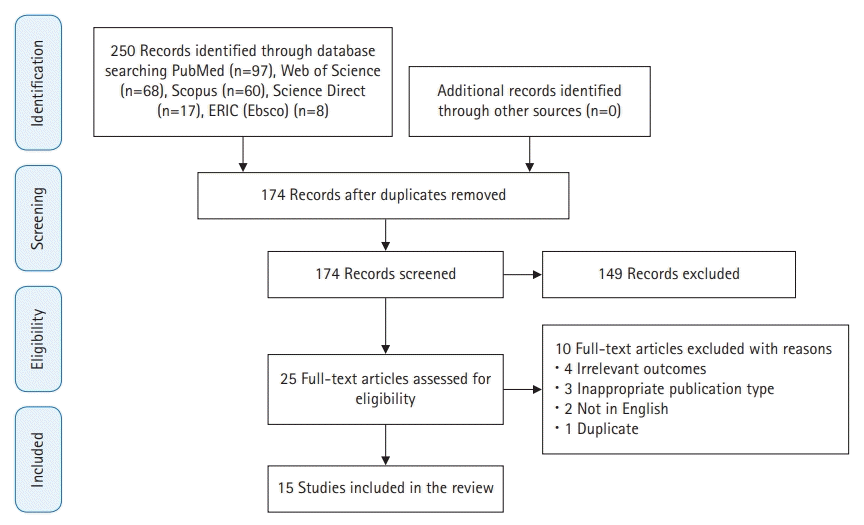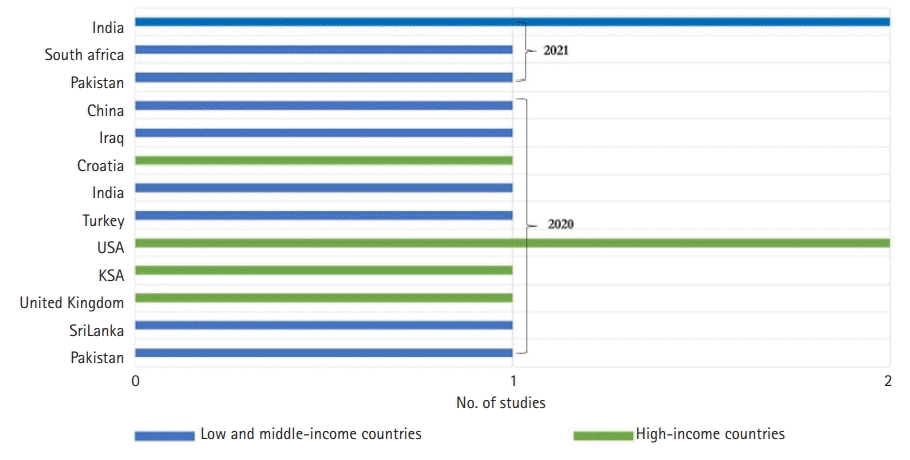Introduction
Rationale
Objectives
Methods
Ethics statement
Registration and protocol
Eligibility criteria
Table 1.
Information sources
Search strategy
Scopus:
(TITLE-ABS (e-learning OR "online learning" OR "distance learning" OR "distance education")) AND (TITLE-ABS ("medical education" OR "nurs* education")) AND (TITLE-ABS (covid-19 OR "2019-novel coronavirus" OR 2019-ncov OR sars-cov-2))
PubMed:
((e-Learning[Title/Abstract] OR "online learning"[Title/Abstract] OR "distance learning"[Title/Abstract] OR "distance education"[Title/Abstract]) AND ("medical education" [Title/Abstract] OR "nursing education"[Title/Abstract])) AND (covid-19 [Title/Abstract] OR "2019-novel coronavirus" [Title/Abstract] OR 2019-ncov [Title/Abstract] OR sars-cov-2[Title/Abstract]).
Selection process
Data collection process
Data items
Study risk of bias assessment
Synthesis methods
Reporting bias assessment
Results
Study selection
Study characteristics
Table 2.
| Study (year) | Country | Study design | Discipline | No. of participants | Instructional design | Used platform | Results | Measurement instruments | Main domains and/or items of questionnaire |
|---|---|---|---|---|---|---|---|---|---|
| Abbasi et al. [11] (2020) | Pakistan | CSS | Medicine and dentistry | Medical students: 204 | Fully online course | NR | P | 23-item questionnaire, developed by the authors (5-point Likert scale) | Future learning preferences, comparison of e-learning with traditional teaching, quality and impact of e-learning, student-teacher interactions, online teaching security |
| Dental students: 178 | |||||||||
| Anwar et al. [12] (2021) | Pakistan | CSS | Medicine and dentistry | 283 | Fully online course | NR | P | 20-item questionnaire, developed by the authors based on the original version of Watkins and his colleagues (5-point Likert scale) | Technology access, online skills and relationships, students’ views and students’ perceptions of possible advantages of e-learning |
| Buthelezi et al. [13] (2021) | South Africa | CSS | Nursing | 60 | Fully online course | Moodle | P | Questionnaire with 23 items, designed by the authors (4-point Likert scale) | Computer access, frequency of use, prior exposure to e-learning platforms, anxiety and attitude towards technology, perceived computer self-efficacy |
| Chandrasinghe et al. [14] (2020) | Sri Lanka | CSS | Medicine | 1,047 | Fully online course | Zoom, Facebook | A | Questionnaire designed by the authors | Relevance and importance of the topic, students’ discussions and clinical sense, discussion and knowledge and understanding of the topic |
| Dost et al. [15] (2020) | UK | CSS | Medicine | 2,721 | Fully online course | NR | P/E | 20-item questionnaire, developed by the authors based in part on the Ready Education Environment Measure (5-point Likert scale) | The use and experience of online teaching during the COVID-19 pandemic, perceived benefits and barriers of online teaching |
| Gupta et al. [16] (2021) | India | CSS | Medicine | 248 | Fully online course | NR | P | 22-item online survey developed by the authors (5-point Likert scale) | Time spent on online and offline learning, modality of didactic learning, interaction with educators, facilitating and hindering factors during online classes, comparison of e-learning with traditional teaching, the features preferred during online classes |
| Ibrahim et al. [17] (2020) | Saudi Arabia | CSS | Medicine | 340 | Fully online course | Zoom, Blackboard | P/A | 21-item data collection sheets from the E-Learning Acceptance Measure and items to assess student perception (7-point Likert scale) | Preferred learning management system, tutor quality, perceived usefulness, facilitating conditions, perceptions regarding the benefits, enablers, and barriers to e-learning |
| Kivlehan et al. [18] (2020) | USA | CSS | Medicine | 30 | Fully online course | Zoom | P | Questionnaire developed by the authors | Perceived benefits and barriers to e-learning, satisfaction with education during the COVID-19 pandemic |
| Kolcu et al. [19] (2020) | Turkey | CSS | Medicine | 941 | Fully online course | Moodle | A | 21-item questionnaire from the Learning Management System Acceptance Scale (5-point Likert scale) | Performance expectancy, effort expectancy, facilitating conditions, social influence |
| Kumar et al. [20] (2020) | India | CSS | Medicine | 600 | Fully online course | Zoom | P | 10-item questionnaire developed by the authors (5-point Likert scale) | Flexibility of learning, achievement of pedagogical objectives, attractivity of the online course |
| Puljak et al. [21] (2020) | Croatia | CSS | Medicine and nursing | 2,520 | Fully online course | NR | P/M | 73-item questionnaire developed by the authors (5-point Likert scale) | Personal experience with e-learning, motivation and attendance, possibility to participate in e-learning, continuation of education during the pandemic |
| Singh et al. [22] (2021) | India | CSS | Medicine and nursing | Medical student: 1,541 | Fully online course | NR | A | 33-item survey, developed by the authors (dichotomous and multiple-choice questions) | Feasibility of online classes, health issues arising from online classes, methods of online teaching, student preferences and attitudes towards e-learning |
| Nursing student: 684 | |||||||||
| Singhi et al. [23] (2020) | USA | CSS | Medicine | 30 | Fully online course | WebEx | P | 19-item survey designed by the authors | Ease of technical access to the online platform, level of comfort with participation, knowledge acquisition, wellness, and COVID-19-specific coverage |
| Tuma et al. [24] (2020) | Iraq | CSS | Medicine | 636 | Fully online course | Google Classroom, Free Conference Call | P | 10-item survey, designed by the authors | The feasibility of educational technology platforms for distance education and the education’s perceived quality |
| Wang et al. [25] (2020) | China | CSS | Medicine | 99,559 | Fully online course | NR | P | 20-item questionnaire developed by the authors based in part on the technology acceptance model (5-point Likert scale) | Prior online learning experiences, perceptions of ongoing online education |
Risk of bias in studies
Table 3.
| Study | Study design |
Sampling |
Type of data |
Validity of the evaluation instrument |
Data analysis |
Outcome |
Total score | |||||||
|---|---|---|---|---|---|---|---|---|---|---|---|---|---|---|
| Institution studied | Response rate score | Internal structure | content | Relationships to other variables | Appropriateness of analysis | Complexity of analysis | Satisfaction, attitudes, perceptions | Knowledge, skills | Behaviors | Patient/health care outcome | ||||
| Abbasi et al. [11] | 1 | 0.5 | 0.5 | 1 | 1 | 1 | 0 | 1 | 2 | 1 | 0 | 0 | 0 | 9 |
| Anwar et al. [12] | 1 | 0.5 | 0.5 | 1 | 0 | 1 | 0 | 1 | 2 | 1 | 0 | 0 | 0 | 8 |
| Buthelezi et al. [13] | 1 | 0.5 | 0.5 | 1 | 0 | 1 | 1 | 1 | 2 | 1 | 0 | 0 | 0 | 9 |
| Chandrasinghe et al. [14] | 1 | 0.5 | 0.5 | 1 | 0 | 0 | 0 | 1 | 1 | 1 | 0 | 0 | 0 | 6 |
| Dost et al. [15] | 1 | 1.5 | 0.5 | 1 | 0 | 1 | 0 | 1 | 2 | 1 | 0 | 0 | 0 | 8 |
| Gupta et al. [16] | 1 | 0.5 | 0.5 | 1 | 0 | 1 | 0 | 1 | 1 | 1 | 0 | 0 | 0 | 7 |
| Ibrahim et al. [17] | 1 | 0.5 | 0.5 | 1 | 1 | 1 | 0 | 1 | 2 | 1 | 0 | 0 | 0 | 9 |
| Kivlehan et al. [18] | 1 | 0.5 | 1 | 1 | 0 | 1 | 0 | 1 | 1 | 1 | 0 | 0 | 0 | 7.5 |
| Kolcu et al. [19] | 1 | 0.5 | 1 | 1 | 1 | 1 | 0 | 1 | 2 | 1 | 0 | 0 | 0 | 9.5 |
| Kumar et al. [20] | 1 | 0.5 | 0.5 | 1 | 0 | 1 | 0 | 1 | 2 | 1 | 1.5 | 0 | 0 | 9.5 |
| Puljak et al. [21] | 1 | 1.5 | 1 | 1 | 0 | 1 | 0 | 1 | 1 | 1 | 0 | 0 | 0 | 8.5 |
| Singh et al. [22] | 1 | 1.5 | 1 | 1 | 0 | 1 | 1 | 1 | 2 | 1 | 0 | 0 | 0 | 10.5 |
| Singhi et al. [23] | 1 | 0.5 | 1 | 1 | 0 | 1 | 0 | 1 | 1 | 1 | 0 | 0 | 0 | 7.5 |
| Tuma et al. [24] | 1 | 0.5 | 0.5 | 1 | 0 | 1 | 0 | 1 | 1 | 1 | 0 | 0 | 0 | 7 |
| Wang et al. [25] | 1 | 1.5 | 1 | 1 | 1 | 1 | 1 | 1 | 2 | 1 | 0 | 0 | 0 | 11.5 |




 PDF
PDF Citation
Citation Print
Print






 XML Download
XML Download